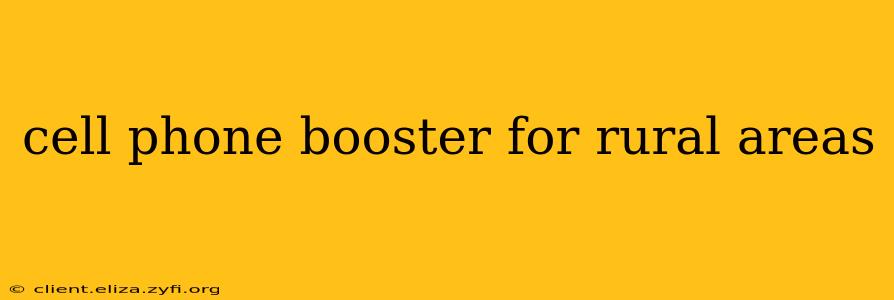Life in rural areas offers a unique blend of tranquility and challenges. While the peace and quiet are undeniable benefits, unreliable cell service can be a significant drawback. For many, consistent cell phone connectivity is crucial for work, emergencies, and staying connected with loved ones. This is where cell phone boosters for rural areas become invaluable. This guide will delve into the world of signal boosters, helping you understand how they work, what to consider when choosing one, and ultimately, how to reclaim your connection.
How Do Cell Phone Boosters Work?
Cell phone boosters, also known as signal repeaters, work by receiving a weak cellular signal, amplifying it, and then retransmitting it within a specific area. They consist of three main components: an outside antenna, an amplifier, and an inside antenna.
-
Outside Antenna: This antenna captures the weak cellular signal from the nearest cell tower. Its placement is crucial for optimal performance, often requiring installation on a high point like a roof or tower.
-
Amplifier: The amplifier boosts the received signal's strength, overcoming the distance and obstacles that weaken the signal.
-
Inside Antenna: This antenna distributes the amplified signal throughout your home or building, providing improved coverage for your cell phones and other wireless devices.
The booster effectively creates a localized network, significantly improving the quality and reliability of your cellular service.
What to Consider When Choosing a Cell Phone Booster
Selecting the right cell phone booster for your rural location requires careful consideration of several factors:
1. Your Specific Cellular Provider:
Not all boosters work with all carriers. Check the booster's compatibility with your specific provider (e.g., Verizon, AT&T, T-Mobile) before purchasing. Some boosters support multiple carriers, while others are carrier-specific.
2. Signal Strength and Coverage Area:
Before purchasing, assess your current signal strength using a signal strength meter app on your phone. This will help determine the level of amplification needed. Consider the size of the area you want to cover – a larger home or building will require a booster with a greater coverage capacity.
3. Frequency Bands:
Cellular carriers use different frequency bands. Ensure the booster supports the frequency bands used by your provider in your specific geographic location. This information is usually available on the carrier's website or by contacting customer support.
4. Installation:
While some boosters are designed for DIY installation, others may require professional assistance, especially for complex setups or larger buildings. Factor in installation costs and complexities when making your decision.
What are the different types of cell phone boosters?
Several types of cell phone boosters cater to different needs and budgets.
1. Single-carrier Boosters: These boosters are designed to amplify signals from a single cellular carrier. They're often more affordable but offer limited flexibility.
2. Multi-carrier Boosters: These boosters can amplify signals from multiple carriers simultaneously, providing a more versatile solution for households with users on different networks.
3. Home Boosters: These are designed for residential use and typically cover a single home or apartment.
4. Building Boosters: These are larger systems designed for commercial use and can cover entire buildings or multiple floors.
5. Vehicle Boosters: These are designed to boost cell phone signals in vehicles, especially beneficial for those who travel frequently in areas with poor cellular coverage.
How much does a cell phone booster cost?
The cost of a cell phone booster varies greatly depending on several factors, including the type of booster (single-carrier versus multi-carrier), the coverage area it provides, and whether professional installation is required. Prices can range from a few hundred dollars for basic home boosters to several thousand dollars for large-scale commercial installations.
Are there any potential drawbacks to using a cell phone booster?
While cell phone boosters offer significant benefits, it’s important to be aware of potential drawbacks:
- Cost: Boosters can be a significant investment, both in terms of the purchase price and potential installation costs.
- Installation complexity: Installing a booster correctly can be challenging, and improper installation can lead to reduced performance or even interference with other electronic devices.
- Interference: In rare cases, a poorly installed or improperly configured booster can cause interference with other electronic devices or even other cellular signals.
Where can I buy a cell phone booster?
Cell phone boosters are available from a variety of online and brick-and-mortar retailers. It’s important to research reputable sellers and read reviews before making a purchase.
By carefully considering these factors and understanding the technology involved, you can choose the right cell phone booster to enhance your cellular connectivity in your rural area, significantly improving your quality of life and access to vital communication services.
